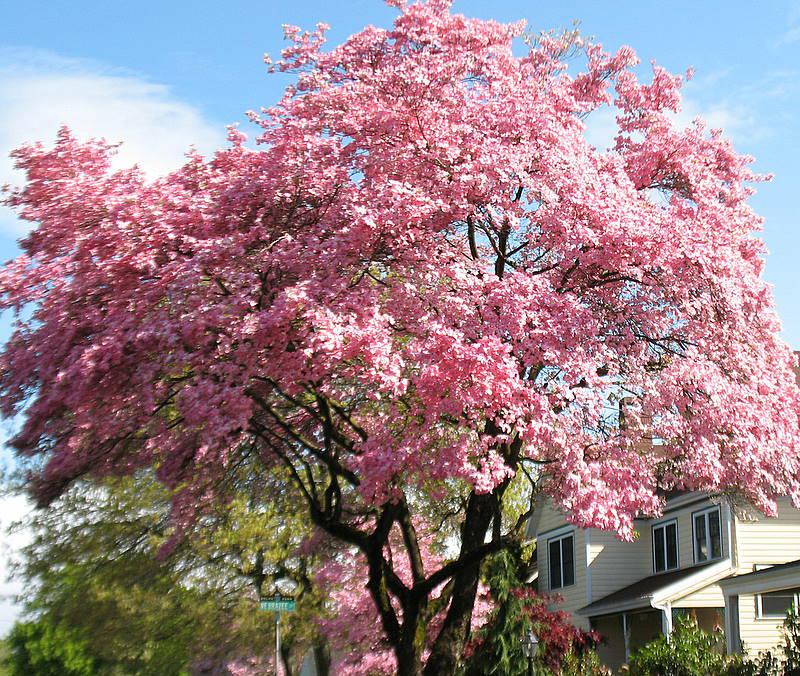The pink dogwood tree, also known as the pink flowering dogwood (Cornus florida f. rubra) is a popular ornamental tree known for its showy pink blooms in spring. As a relatively small deciduous tree, pink dogwoods make an excellent focal point in landscapes and gardens. If you’re considering adding one of these beauties to your outdoor space you likely want to know – how big do pink dogwood trees get?
Mature Size of Pink Dogwood Trees
Pink dogwoods are classified as small trees, reaching a mature height of 15-30 feet tall with an equal spread of 15-30+ feet wide. They have a rounded, horizontal branching structure with a flattened top. The branches extend elegantly outward and slightly droop at the ends.
These compact dimensions make them well-suited for planting near homes, along borders and walkways, or anywhere a focal point is desired. They can be grown as single specimens or grouped together for a lush, colorful effect in spring.
Their relatively small size also makes them ideal for smaller residential landscapes. With strategic placement, they can provide color while not overwhelming or obscuring the home.
Growth Rate
Pink dogwoods are slow-growing trees, adding anywhere from just 1-2 feet of growth per year once established They may take 2-3 years after planting as bare root saplings to really get growing.
With time and optimal conditions, they will eventually reach their full mature stature and breadth. However, pink dogwoods are long-lived trees, capable of thriving for over 100 years. This means you’ll enjoy their graceful form and spring blooms for decades to come.
Factors Affecting Size
While pink dogwoods typically reach 15-30 feet at maturity, their ultimate size can be affected by a few key factors:
- Growing Conditions – Like most plants, pink dogwoods will thrive and reach their fullest potential in ideal growing conditions. This includes fertile, acidic, well-draining soil and a site with full sun to partial shade. Insufficient light or poor soil can result in a smaller tree.
- Pruning – Judicious pruning in a dogwood’s youth helps promote a strong structure capable of supporting a full canopy Neglecting structural pruning can lead to a stunted, misshapen form
- Environment – Pink dogwoods prefer moist, humid climates. In hot, dry regions they are more likely to be shorter lived and smaller at maturity. Providing supplemental irrigation can help overcome environmental challenges.
- Cultivar – There are a few named cultivars of pink dogwood that naturally grow smaller than the straight species. ‘Cherokee Chief’ and ‘Cherokee Brave’, for example, mature at around 15 feet tall.
Caring for Pink Dogwoods
To help your pink dogwood thrive and reach its potential size, be sure to care for it properly:
- Choose an appropriate planting site with partial shade and moist, acidic, well-draining soil.
- Water the tree regularly for the first 2 years after planting, then only during drought.
- Apply a 2-3 inch layer of organic mulch around the base to retain moisture.
- Fertilize the tree once yearly in early spring with a balanced, slow-release formula.
- Prune only when necessary to remove dead or damaged growth.
- Monitor for pests like borers and diseases like powdery mildew.
- Protect the tree from harsh winter winds and cold by wrapping the trunk.
With the right growing conditions and proper care, your pink dogwood will flourish into a beautiful focal point tree, gracing your landscape with its blushing spring blooms for years to come.
Other Key Facts About Pink Dogwood Trees
- Bloom color ranges from pale to deep pink, with some white. The blooms appear in spring before the leaves emerge.
- The leaves are oval, 3-6 inches long, with smooth edges. The foliage turns a purplish-red color in fall.
- The tree produces vibrant red berries in late summer that attract birds and wildlife.
- The bark is square-cracked and reddish-brown, providing winter interest.
- Pink dogwoods thrive in USDA Hardiness Zones 5-9. They can tolerate cold winters and hot, humid summers.
- There are a few named cultivars available, like ‘Cherokee Chief’, ‘Cherokee Brave’, and ‘Rubra’.
- Pink dogwoods make excellent specimen trees but also pair well with azaleas, spirea, viburnum, and other ornamentals.
How Much Sunlight Can A Pink Dogwood Tree Take?
If you live somewhere where it gets below freezing in the winter, you should plant pink dogwood trees in full sun or partial shade so they don’t get too much afternoon sun. The more sunlight your tree receives, the faster it will grow and flower.
What Is A Pink Dogwood Tree?
A pink dogwood tree is a medium-sized deciduous flowering tree. It grows 25 to 30 feet tall and can spread up to 20 feet wide. The bark is smooth dark gray-brown, and the branches are lighter gray-brown.
5 Favorite Flowering Dogwood Trees | NatureHills.com
FAQ
Where is the best place to plant a pink dogwood?
How many years does it take for a pink dogwood to bloom?
Can you keep a Dogwood tree small?
How long does it take a Dogwood tree to grow to full size?
- A Complete Guide to Caring for Yuki Cherry Blossom Shrub - January 23, 2025
- Identifying Red Hot Poker Seeds: What to Look For When Harvesting Torch Lily Pods - January 23, 2025
- A Complete Guide to Harvesting Evening Primrose Seeds - January 23, 2025

